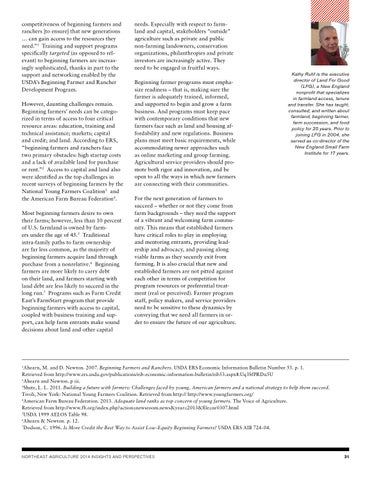competitiveness of beginning farmers and ranchers [to ensure] that new generations … can gain access to the resources they need.”1 Training and support programs specifically targeted (as opposed to relevant) to beginning farmers are increasingly sophisticated, thanks in part to the support and networking enabled by the USDA’s Beginning Farmer and Rancher Development Program. However, daunting challenges remain. Beginning farmers’ needs can be categorized in terms of access to four critical resource areas: education, training and technical assistance; markets; capital and credit; and land. According to ERS, “beginning farmers and ranchers face two primary obstacles: high startup costs and a lack of available land for purchase or rent.”2 Access to capital and land also were identified as the top challenges in recent surveys of beginning farmers by the National Young Farmers Coalition3 and the American Farm Bureau Federation4. Most beginning farmers desire to own their farms; however, less than 10 percent of U.S. farmland is owned by farmers under the age of 45. 5 Traditional intra-family paths to farm ownership are far less common, as the majority of beginning farmers acquire land through purchase from a nonrelative.6 Beginning farmers are more likely to carry debt on their land, and farmers starting with land debt are less likely to succeed in the long run.7 Programs such as Farm Credit East’s FarmStart program that provide beginning farmers with access to capital, coupled with business training and support, can help farm entrants make sound decisions about land and other capital
needs. Especially with respect to farmland and capital, stakeholders “outside” agriculture such as private and public non-farming landowners, conservation organizations, philanthropies and private investors are increasingly active. They need to be engaged in fruitful ways. Beginning farmer programs must emphasize readiness – that is, making sure the farmer is adequately trained, informed, and supported to begin and grow a farm business. And programs must keep pace with contemporary conditions that new farmers face such as land and housing affordability and new regulations. Business plans must meet basic requirements, while accommodating newer approaches such as online marketing and group farming. Agricultural service providers should promote both rigor and innovation, and be open to all the ways in which new farmers are connecting with their communities.
Kathy Ruhf is the executive director of Land For Good (LFG), a New England nonprofit that specializes in farmland access, tenure and transfer. She has taught, consulted, and written about farmland, beginning farmer, farm succession, and food policy for 25 years. Prior to joining LFG in 2004, she served as co-director of the New England Small Farm Institute for 17 years.
For the next generation of farmers to succeed – whether or not they come from farm backgrounds – they need the support of a vibrant and welcoming farm community. This means that established farmers have critical roles to play in employing and mentoring entrants, providing leadership and advocacy, and passing along viable farms as they securely exit from farming. It is also crucial that new and established farmers are not pitted against each other in terms of competition for program resources or preferential treatment (real or perceived). Farmer program staff, policy makers, and service providers need to be sensitive to these dynamics by conveying that we need all farmers in order to ensure the future of our agriculture.
Ahearn, M. and D. Newton. 2007. Beginning Farmers and Ranchers. USDA ERS Economic Information Bulletin Number 53. p. 1. Retrieved from http://www.ers.usda.gov/publications/eib-economic-information-bulletin/eib53.aspx#.Uq3SfPRDu5U 2 Ahearn and Newton. p iii. 3 Shute, L. L. 2011. Building a future with farmers: Challenges faced by young, American farmers and a national strategy to help them succeed. Tivoli, New York: National Young Farmers Coalition. Retrieved from http:// http://www.youngfarmers.org/ 4 American Farm Bureau Federation. 2013. Adequate land ranks as top concern of young farmers. The Voice of Agriculture. Retrieved from http://www.fb.org/index.php?action=newsroom.news&year=2013&file=nr0307.html 5 USDA 1999 AELOS Table 98. 6 Ahearn & Newton. p. 12. 7 Dodson, C. 1996. Is More Credit the Best Way to Assist Low-Equity Beginning Farmers? USDA ERS AIB 724-04. 1
Northeast Agriculture 2014 Insights and Perspectives
31
